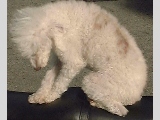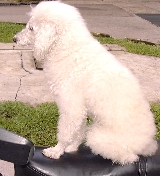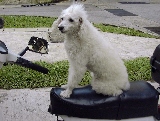|
 Mr and Mrs Tang are a very cheerful couple in their fifties.
They have no children. The Bischon Frise dog is their child. He would sit
under the table while Mr Tang does his work, painting gold over little statutes of Buddha
and welding some other tourist medallion souvenirs for sale. Fine paint dust and
other metallic chemicals would spray onto the little dog as Mr Tang finishes his
handicraft for delivery to the shops on his trusty scooter. Mr and Mrs Tang are a very cheerful couple in their fifties.
They have no children. The Bischon Frise dog is their child. He would sit
under the table while Mr Tang does his work, painting gold over little statutes of Buddha
and welding some other tourist medallion souvenirs for sale. Fine paint dust and
other metallic chemicals would spray onto the little dog as Mr Tang finishes his
handicraft for delivery to the shops on his trusty scooter.
The Bischon Frise felt itchy all over the body. When he could not stand it anymore,
Mr Tang would bring him on his scooter to the veterinarian. The coat was clipped
and the dog recovered.
However there were two areas on the back which became itchy again.
Mr Tang said: "The dog had been clipped and had recovered most of his hair. I
rubbed brandy onto the back area to relieve the itch. Why is it dark brown?"
"Of course, the brandy will not promote hair growth and the skin area became brown
and pigmented owing to prolonged application and rubbing." Dr Melissa Chua
said.
There are many causes of hair loss in the older dog. It is best to work closely with
your vet to solve the problem. In this case, it would be an allergic reaction to
chemical dusts onto the top of the body.
 The rest of the body was not itchy when the owner brought in the dog to the vet
for examination early in the start of the allergic reactions. A few red rashes would be
seen on the back, above the spinal region. Most likely a protective coat over his
chest would have prevented contact with the chemical dust. The rest of the body was not itchy when the owner brought in the dog to the vet
for examination early in the start of the allergic reactions. A few red rashes would be
seen on the back, above the spinal region. Most likely a protective coat over his
chest would have prevented contact with the chemical dust.
 If the dog continues scratching, the whole body will get itchy in a few months' time. If the dog continues scratching, the whole body will get itchy in a few months' time.
A visit to the home of some cases may reveal why the dog has recurrent hair shedding and
itch.
Some
anti-itch drugs given on a regular basis may help as most Singapore owners dislike putting
on protective vests for their beloved pets. A Bischon without skin itch has a thick
white coat, like a lamb. However, such drugs may become ineffective or need a larger
dose over the period of years of use. |
 TOA
PAYOH VETS
TOA
PAYOH VETS TOA
PAYOH VETS
TOA
PAYOH VETS